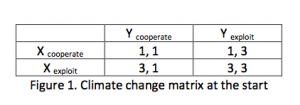Game Theory: Climate Change
With the recent event of Hurricane Irma, some scientists have attributed the hurricane to be linked to Climate Change. Climate change is described as changes to regional and global climate patterns due to increased levels of greenhouse gases originating from humans. Despite a large scientific backing and acknowledgement of climate change from nations around the world, there are still quite a number of individuals that do not believe in the notion that climate change is real. Although there is definitely some disagreement on this issue, it is well agreed upon by those who do accept that anthropogenic sources of carbon has played a large role in climate change that mitigating the effects of climate change would require a global effort as seen with the Paris Agreement.
The article discusses how game theory could be used to assess whether nations or cities would partake in cooperating to mitigate climate change or exploiting the environment for resources using a method analogous to the Prisoner’s Dilemma . The first example that is discussed is when resources are abundant. The author had described the values based on a number of considerations including value of resources, costs of climate change, policy costs, etc. Figure 1 indicates the values that the author used in this scenario.
Regardless of the values actually used, it is important to note that exploitation yields greater rewards than cooperation due to there not being an environmental danger at the time. In this case, both X and Y should choose to exploit the environment as it is the best possible outcome for both of them (Yielding 3 in each case). A situation like the aforementioned one is in Kentucky and West Virginia as both states should optimize energy production and profits as neither of them have any incentive to protect the environment and are competing with another for jobs and productivity.
The second situation that is described is when resources are depleted and the environment is in danger of collapsing. Using the same evaluation method, Figure 2 describes this scenario.

Using the same method, we can see that it would be more favorable to cooperate for both X and Y as it would yield 1 at best, and 0.5 at worst as opposed to if they chose to exploit the environment which would yield 0.5 at best and 0 at worst. In this scenario, exploitation would be less favorable as the environment is already depleted of resources and damaged to the point protection appears more favorable as ecosystem collapse has a number of negative outcomes which benefit neither X or Y. The article describes the above situation as a development of the first situation over time.
Lastly, the article discusses the situation between nations on whether to exploit the environment or not.

Cooperation would yield in a more favorable results than most, but it is not the most optimal action of either X or Y. The optimal action would be to exploit the environment as it yields the best outcomes to oneself (-7 or -10 as opposed to -8 or -11). This may explain why a number of nations have not agreed to cooperate on climate change as it is more favorable for oneself to exploit the environment. This situation is the most similar to the Prisoner’s Dilemma.
In class, we went over the Prisoner’s Dilemma as a method of choosing the most optimal choices. Just through game theory and analyzing our options using a method that is analogous to the Prisoner’s Dilemma, we are able to predict which approaches nations or states are likely to take when presented with a certain situation. As stated in the article, exploitation is likely when resources are abundant, cooperation and environmental protection is more likely to happen when resources are scarce, and nations may continue the route of environmental exploitation as it is the most optimal strategy. Although a lot of simplification was done, these types of analyses could be used for future implementation of any environmental policy pertaining to climate change and whether a state or nation should adopt such policies. Although a large majority of people would like to work together and mitigate the effects of climate change, game theory shows that it may often be in the best interests of oneself and others to continue exploitation.
**All figures are from the article.
Source:
https://www.theatlantic.com/notes/2016/04/climate-change-game-theory-models/479340/

